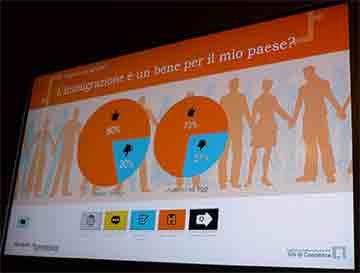|

Navigating Differences
Contact: Bix Gabriel, 646-755-6183 Ellis Island, NY/NJ — Is immigration good for my country? Is immigration good for my community? Is immigration good for me? Starting November 17, visitors to the Statue of Liberty National Monument and Ellis Island will have the chance to respond to these simple but provocative questions. Navigating Difference, an interactive installation opening at three immigration-related Sites of Conscience – Ellis Island National Museum of Immigration (New York), Le Bois du Cazier (Charleroi) and Galata Museo del Mare - Mu.MA (Genoa) – invites visitors to respond to these questions and compare their responses to those gathered at every site. The installation launches November 17, 2011 and will remain open through early 2012. The project was coordinated by the International Coalition of Sites of Conscience and funded by Museums & Community Collaborations Abroad. Interface of Navigating Difference shows what percentage of visitors voted "yes" or "no." But the installation is the jump-off point for more. Each museum is also hosting community dialogues bringing together groups of people with differing perspectives on immigration to delve into why people immigrated then and now, and what their experiences can entail. What is the goal? To help visitors navigate the complexities of migration and inspire more informed public discourse about immigration today. At the National Park Service's National Museum of Immigration on Ellis Island: "Where are the public spaces for people today to talk openly and productively about immigration?" asks Elizabeth Silkes, Executive Director of the International Coalition of Sites of Conscience, a global network of museums that use history to inspire civic action today. "Sites like ours are today's new civic spaces because they use the past to invite reflection on the present, which enables a richer conversation - and hopefully, inspires constructive action." Facilitating conversations about sensitive social issues by connecting past and present is the hallmark of the Sites of Conscience movement, which advances using open discussion as a tool for coming to terms with difficult histories and using the power of the past to engage people in making a difference in the present. More about Navigating Difference: www.sitesofconscience.org/categories/activities/navigating-difference Photos of Navigating Difference: www.flickr.com/groups/navigatingdifference Facebook page: www.facebook.com/NavigatingDifference. Funding for Navigating Difference was provided in part by the Museums & Communities Collaborations Abroad Program, which is made possible by the U.S. Department of State's Bureau of Educational and Cultural Affairs and administered by the American Association of Museums. ABOUT THE PARTICIPANTS International Coalition of Sites of Conscience We are a worldwide network of "Sites of Conscience" – historic sites, museums and initiatives that activate the power of places of memory to engage the public with a deeper understanding of the past and inspire action to shape a just future. The Coalition provides member sites with direct funding for civic engagement programs, organizes learning exchanges ranging from one-on-one collaborations to international conferences, and conducts strategic advocacy for sites and the Sites of Conscience movement. Learn more at www.sitesofconscience.org. Statue of Liberty National Monument and Ellis Island Le Bois du Cazier On August 8th, 1956, a fire spread through the Bois du Cazier coal mine in Marcinelle, Belgium, claiming the lives of 262 men of 12 different nationalities. More than half of the victims were immigrants from Italy, who filled the need for laborers in Belgium's economic heartland. The tragedy put an end to a decade-old worker treaty between Belgium and Italy and led to stricter safety regulations for coal miners across the nation. A visit to Le Bois du Cazier encourages visitors to question the costs and benefits of industrialization and to consider issues of workplace safety. The site also offers visitors the opportunity to reflect on the lives and contributions of immigrants in Belgium and the factors influencing immigration policy today. Learn more at http://www.leboisducazier.be/index_en.htm. Galata Museo del Mare (Mu.Ma) This maritime museum in Genoa, Italy focuses on the city's seafaring history, including its legacy as an emigration port. In the interactive exhibit "From Genoa to Ellis Island," visitors take on the roles of emigrants who left Italy for the Americas between 1892 and 1914. Armed with a passport and ticket, visitors walk in the shoes of thousands before as they prepare for the voyage, travel overseas, undergo screening at Ellis Island, and settle in New York City. This exhibit, a key step in building the planned Emigration Museum at Mu.MA, asks us to explore how immigration affects not only the destination nation but also the home country, both socially and economically. Learn more at http://www.galatamuseodelmare.it/jsp/index.jsp. |
Last updated: February 26, 2015
